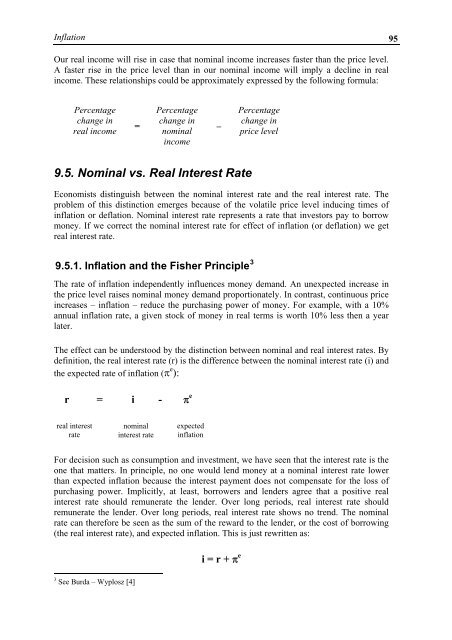MacroeconomicsI_working_version (1)
Create successful ePaper yourself
Turn your PDF publications into a flip-book with our unique Google optimized e-Paper software.
Inflation 95<br />
Our real income will rise in case that nominal income increases faster than the price level.<br />
A faster rise in the price level than in our nominal income will imply a decline in real<br />
income. These relationships could be approximately expressed by the following formula:<br />
Percentage<br />
change in<br />
real income<br />
Percentage<br />
=<br />
change in<br />
nominal<br />
–<br />
income<br />
Percentage<br />
change in<br />
price level<br />
9.5. Nominal vs. Real Interest Rate<br />
Economists distinguish between the nominal interest rate and the real interest rate. The<br />
problem of this distinction emerges because of the volatile price level inducing times of<br />
inflation or deflation. Nominal interest rate represents a rate that investors pay to borrow<br />
money. If we correct the nominal interest rate for effect of inflation (or deflation) we get<br />
real interest rate.<br />
9.5.1. Inflation and the Fisher Principle 3<br />
The rate of inflation independently influences money demand. An unexpected increase in<br />
the price level raises nominal money demand proportionately. In contrast, continuous price<br />
increases – inflation – reduce the purchasing power of money. For example, with a 10%<br />
annual inflation rate, a given stock of money in real terms is worth 10% less then a year<br />
later.<br />
The effect can be understood by the distinction between nominal and real interest rates. By<br />
definition, the real interest rate (r) is the difference between the nominal interest rate (i) and<br />
the expected rate of inflation (π e ):<br />
r = i - π e<br />
real interest<br />
rate<br />
nominal<br />
interest rate<br />
expected<br />
inflation<br />
For decision such as consumption and investment, we have seen that the interest rate is the<br />
one that matters. In principle, no one would lend money at a nominal interest rate lower<br />
than expected inflation because the interest payment does not compensate for the loss of<br />
purchasing power. Implicitly, at least, borrowers and lenders agree that a positive real<br />
interest rate should remunerate the lender. Over long periods, real interest rate should<br />
remunerate the lender. Over long periods, real interest rate shows no trend. The nominal<br />
rate can therefore be seen as the sum of the reward to the lender, or the cost of borrowing<br />
(the real interest rate), and expected inflation. This is just rewritten as:<br />
3 See Burda – Wyplosz [4]<br />
i = r + π e




